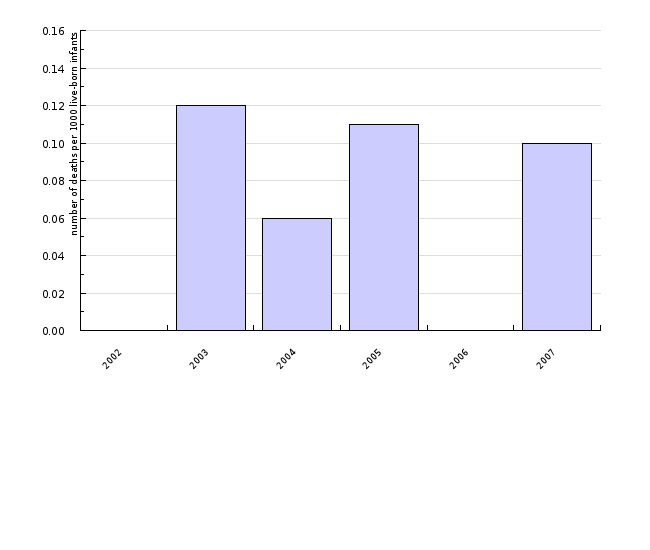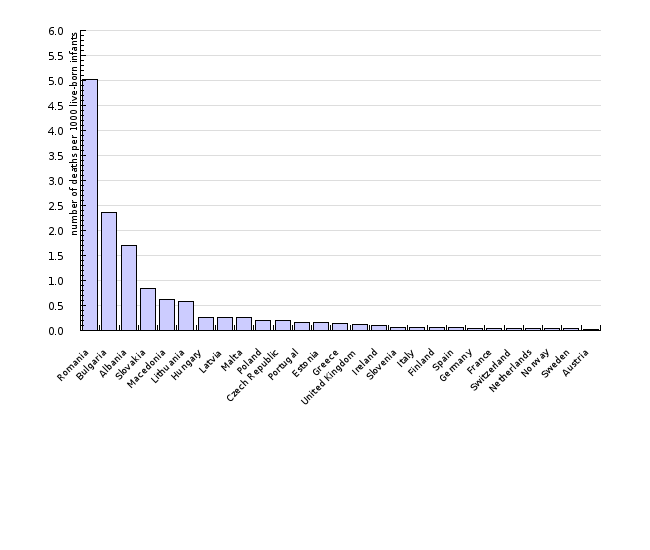[ZD01] Infant mortality rate from respiratory diseases

Key message

Some 13.6% of all infant mortality in Europe is due to respiratory diseases. The data for Slovenia show that, on average, 6.55% of all deaths of infants aged between 28 and 364 days were from respiratory diseases in the period 2002–2007 (Institute of Public Health of the Republic of Slovenia, 2009). Research has shown a relationship between the air pollution rate and the infant mortality rate due to respiratory diseases (WHO, 2007). The relationship is a rather complex one, in particular on account of the impact of various external factors (allergens, cigarette smoke, diet, lifestyle and similar).
Definition
The indicator shows the mortality rate of infants aged from 1 month to 1 year due to respiratory diseases that may also have been a consequence of exposure to polluted air. The analysis of mortality rate relates to the period 2002–2007. The infant mortality rate for 2006 in selected European countries is given for comparison with Slovenia.
The infant mortality rate due to respiratory diseases is one of the indicators providing an indirect assessment of how exposure to negative environmental factors affects the health of children and, in particular, infants. The infant mortality rate from respiratory diseases depends on a number of factors, including the quality of indoor and outdoor air (WHO, 2005).
Charts
Database of the Institute of Public Health of the Republic of Slovenia, 2009
| 2002 | 2003 | 2004 | 2005 | 2006 | 2007 | ||
|---|---|---|---|---|---|---|---|
| Celje | number of deaths per 1000 live-born infants | 0 | 2.58 | 0 | 0 | 0 | 0 |
| Ljubljana | number of deaths per 1000 live-born infants | 0 | 0 | 0 | 0 | 0 | 0 |
| Maribor | number of deaths per 1000 live-born infants | 0 | 0 | 0 | 0 | 0 | 0 |
| Slovenija | number of deaths per 1000 live-born infants | 0 | 0.12 | 0.06 | 0.11 | 0 | 0.1 |
Database of the Institute of Public Health of the Republic of Slovenia, 2009
| 2002 | 2003 | 2004 | 2005 | 2006 | 2007 | ||
|---|---|---|---|---|---|---|---|
| Live-born infants - total | nmb. | 17583 | 17160 | 17900 | 18199 | 19029 | 19915 |
| Infant mortality - total | nmb. | 13 | 16 | 21 | 21 | 17 | 16 |
| Infant deaths from respiratory diseases | nmb. | 0 | 2 | 1 | 2 | 0 | 2 |
| Proportion of deaths of infants | % | 12.5 | 4.8 | 9.5 | 12.5 |
Database of the Institute of Public Health of the Republic of Slovenia, 2009
| Romania | Bulgaria | Albania | Slovakia | Macedonia | Lithuania | Hungary | Latvia | Malta | Poland | ||
|---|---|---|---|---|---|---|---|---|---|---|---|
| Infant mortality rates | number of deaths per 1000 live-born infants | 5.019 | 2.361 | 1.707 | 0.834 | 0.614 | 0.571 | 0.258 | 0.254 | 0.254 | 0.204 |
| Czech Republic | Portugal | Estonia | Greece | United Kingdom | Ireland | Slovenia | Italy | Finland | Spain | ||
| Infant mortality rates | number of deaths per 1000 live-born infants | 0.192 | 0.16 | 0.158 | 0.139 | 0.124 | 0.11 | 0.057 | 0.056 | 0.053 | 0.052 |
| Germany | France | Switzerland | Netherlands | Norway | Sweden | Austria | |||||
| Infant mortality rates | number of deaths per 1000 live-born infants | 0.041 | 0.039 | 0.038 | 0.035 | 0.035 | 0.033 | 0.025 |
Goals
A measure to reduce the infant mortality rate due to respiratory diseases is prevention of exposure to risk factors that can lead to premature death. Since there are a number of risk factors causing premature deaths of infants, the environmental field can indeed address this issue by reducing the level of particulate matter air pollution.
Comment
Acute lower respiratory infections, in particular pneumonia, are frequent cause of death and serious morbidity in young children and infants (Commission of the European Communities, 2005). The most frequent cause of infant deaths from respiratory diseases is infections of the lower respiratory tract. Causative infective agents differ between developed and developing countries of Europe – bacteria are most common in developing countries and viruses in developed countries. Research has shown a relationship between air pollution rate and infant mortality rate due to respiratory diseases (WHO, 2007).
The average infant mortality rate due to respiratory diseases in Europe is 0.8 per 1000 live-born infants. A detailed breakdown for EU countries is shown in Figure ZD1-3. The infant mortality rate differs greatly from country to country (e.g. 0.025 in Austria and 6.2 in Kyrgyzstan, per 1000 live-born infants). Some 13.6% of all infant deaths are due to respiratory diseases. In general, the infant mortality rate is considerably higher in Eastern Europe than in Western Europe (ENHIS - European Environment and Health Information System, 2007).
In Slovenia, data on infant mortality are collected on a regular basis. The data for the past 6 years indicate a fairly stable infant mortality rate due to respiratory diseases in the country and individual towns and cities (Figure ZD1-2). The data are comparable to the infant mortality rate due to respiratory diseases in the developed countries of Western Europe.
The data for Slovenia (Figure ZD1-1) show that the infant mortality rate due to respiratory diseases in children aged between 28 and 364 days in the period 2002–2007 ranges from 0 to 0.12 per 1000 live-born infants (the highest in 2003). In Celje, Ljubljana and Maribor, the infant mortality rate due to respiratory diseases in children aged between 28 and 364 days is not higher compared to other parts of Slovenia; only one death was recorded in the period 2002–2007 in Celje. Throughout Slovenia, seven infants died in this period due to respiratory diseases. The data show that the proportion of children aged between 28 and 364 days who died in Slovenia from respiratory diseases in the period 2002–2007 was, on average, 6.55% of whole infant mortality (from 0.0% to 12.5%) (Institute of Public Health of the Republic of Slovenia, 2009).
The relationship between the infant mortality rate due to respiratory diseases and indoor air quality is a rather complex one. A variety of respiratory disease forms occur due to several causes, such as outdoor air pollution, the presence of pollutants and allergens inside homes (e.g. deriving from solid fuels used for cooking and heating, tobacco smoke and dust) and because of the presence of infectious agents. Moreover, diet, lifestyle, environmental and sociological factors may be significant and may also have a synergistic effect (Commission of the European Communities, 2005).
In the countries of Western Europe, the infant mortality rate due to respiratory diseases is very low, probably because these countries are highly developed in economic and social terms, and there is more effective environmental legislation in place. The infant mortality rate due to respiratory diseases is most likely a consequence of increasingly resistant micro-organisms, the emergence of new pathogens or the lack of effective antiviral medications. Respiratory diseases are usually discovered at an early stage and treatment starts immediately.
Methodology
Data for Slovenia
Data on mortality rates are collected according to the Healthcare Databases Act (Official Gazette of the Republic of Slovenia, No. 65/00).
Objectives summarized by: Children's Environment and Health Action Plan for Europe - CEHAPE (June 2004)
Source database or source: Official data were used on the number of infant deaths due to respiratory diseases, as incorporated in the database of the Institute of Public Health of the Republic of Slovenia.
Data administrator: Institute of Public Health of the Republic of Slovenia
Data acquisition date for this indicator: 9 June 2009
Methodology and frequency of data collection for the indicator: The data cover the period from 2002 to 2007 and were collected on an annual basis.
Data processing methodology: For transparency purposes, the data on the infant mortality rate due to respiratory diseases are presented as proportions.
Information concerning data quality:
- Advantages and disadvantages of the indicator: Officially reported data were used to calculate the indicator.
- Relevance, accuracy, robustness, uncertainty:
Reliability of the indicator (archival data): Reliable
Uncertainty of the indicator (scenarios/projections): Projections have not been elaborated
- Overall assessment (1 = no major comments, 3 = data to be considered with reservation):
Relevance: 1
Accuracy: 1
Completeness over time: 1
Completeness over space: 1
Data for Europe
WHO was the leader organisation of the ENHIS (European Environment and Health Information System) project. The project was completed in 2008. Every country remains the administrator of its own data. Data on the infant mortality rate were acquired from the WHO database.
Source database or source: WHO database on the mortality rate
Data acquisition date for the indicator: 2006
Methodology and frequency of data acquisition for the indicator: Data are collected on an annual basis.
Data processing methodology: The number of infant deaths per number of live-born infants
Information concerning data quality:
- Advantages and disadvantages of the indicator: Officially reported data were used to calculate the indicator.
- Relevance, accuracy, robustness, uncertainty:
Reliability of the indicator (archival data):
Uncertainty of the indicator (scenarios/projections): Projections have not been elaborated.
- Overall assessment (1 = no major comments, 3 = data to be considered with reservation):
Relevance: 1
Accuracy: 1
Completeness over time: 1
Completeness over space: 1
Methodology and frequency of data collection for the indicator: Data are collected on an annual basis; data on diagnosis, age and municipality of birth were used.
Other sources and literature:
- Effects of air pollution on children's health and development- a review of the evidence. WHO European Centre fot Environment and Health. Copenhage: WHO Regional office for Europe, 2005. (6 March 2007).
- ENHIS, 2007. Infant mortality from respiratory diseases. World Health Organization, Europe.
- Indoor air pollution. Geneva: World Health Organisation, 2007. (6 March 2007).
- Infant mortality from respiratory diseases. ENHIS Fact sheet no. 3.2. ENHIS, May 2007.
- Technical Working Group on Priority Diseases. Baseline report on respiratory health in the framework of the European environment and health strategy. Brussels, Commission of the European Communities, 2003 (COM (2003)338 final). (8 March 2007).











